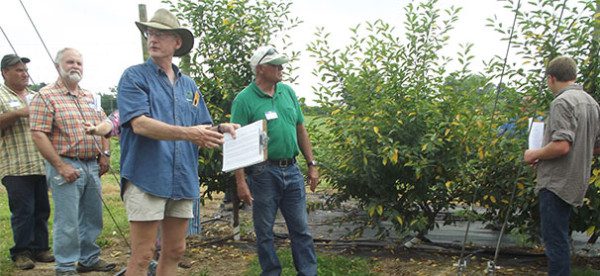

Aug 1, 2013Researchers eye high-density cherry harvest
Michigan researchers continue to explore the potential for establishing high-density systems for tart cherry hedgerow production that can lead to more effective over-the-row harvests.
Part of the process has involved the planting of Montmorency trees on vigorous Mahaleb rootstock trained to the Upright Fruiting Offshoots (UFO) system. This also is known as a bi-lateral cordon training system, a method more commonly used in winegrape vineyards.
The trial findings have been encouraging.
“We’re very pleased to see that Montmorency on Mahaleb rootstock has been able to maintain small trees with a very nice crop in the fourth year,” said Michigan State University (MSU) horticulturist Greg Lang.
Lang was joined by MSU horticulturist Ron Perry and Dan Guyer, an agricultural engineer with MSU’s Department of Biosystems and Agricultural Engineering, in a presentation at the July 9 Cherry Variety and High-Tech Research Showcase. The event was held at MSU’s research center in Clarksville, Mich.
Guyer’s work has involved gauging the effectiveness of commercially fabricated over-the-row mechanical harvesters designed for bramble and blueberry production on small, compact tart cherry trees.
Similar to what growers in Poland – seeking to trim labor costs – have found, a commercial berry harvester with a mechanism known as the Rotary-Tine-Tower has been effective in removing fruit.
“When we started this in 2008, one of the things we found was that Poland was using something similar to a blueberry harvester that has two spindles with fiberglass tines that vibrate and shakes fruit off,” Perry said.
Cherry growers have traditionally optimized tree growth for up to six years, in order to develop enough trunk hardiness to avoid injury from mechanical shakers. The blueberry-type harvester can cut that wait time considerably, and is working wonders on UFO-type systems.
“We’ve been using it for three or four years, and it’s practically perfect,” Perry said. “It does the job with very little fruit left in the tree and little fruit damage. We don’t see any trunk damage.”
With the harvester’s viability largely resolved, Perry said the next step is to focus on restricting tree canopy size.
“That’s our biggest challenge right now,” he said. “The mechanical harvester does work. Now it’s up to us horticulturalists to try and figure out a way to keep that canopy compact, because the harvester we’re using has a fairly limited tunnel and dimension. It’s 5 by 8 feet, and can allow a canopy up as high as 10 feet and as wide as 7 feet.
“We’re starting these branches down as low as a foot,” Perry said of the low-profile trees. “Since 1967 until now, in our traditional orchards we’ve had a trunk shoot with branches starting around 3 and a half to 4 feet.
“We’re completely reversing everything the traditional tart cherry growers are doing,” he said. “We want fruit in the initial years because fruit competes with shoot growth. If you have fruit there, basically it’s acting like a pair of pruning shears for us to keep that canopy small.
“In many respects, what we’re doing is stepping out in a whole new era and a frontier in doing this because it hasn’t been done in our sour cherry industry,” Perry said.
One of the project’s early plots in southwest Michigan consists of 20 acres of high-density trees spaced 5 feet apart.
“We’ve already started running that system and it’s working very cleanly and smoothly,” Perry said. “The machine is moving at about 1 mile per hour, and it’s removing 98 percent of the fruit.
“My big challenge is how to keep that (canopy) small enough,” Perry said. “Some of the things we might consider are some summer hedging at 45 days post bloom, recycling the branches down low, looking at a multi-trunked system where we can recycle the trunks. We’re still in the learning stage of how to do this best.
“Montmorency and many of these sour cherries are extremely accommodating to a lot of severe pruning, and they are able to throw shoots again and flower again after you’ve made cuts.
“We’re looking at different approaches – not only the pruning and training aspects but also the potentiality for rootstocks that will keep the canopy small,” Perry said. “We may get into root pruning in the future to try and keep some of the trees down that get too large for our blueberry harvester.
“I will tell you the machine works, so we just need to find the best ways to keep the tree as compact as possible so the harvester can do its job,” he said. “I don’t know where it’s headed and whether the economics will pay, but certainly we’re talking about a return on investment earlier in the life of the tree and of the orchard.”
Guyer believes the approach will reduce mechanical damage and soft fruit, which pose so many challenges for the industry, particularly later in the season.
“You won’t be having those 18- to 20-foot trees where cherries are dropping from that distance down to a very tight tarp,” Guyer said. “With 96 percent high quality or whatever it is, we’re just flabbergasted at how well this canopy shaking system is doing in the quality of the fruit.”
“Some of the exciting things that I think this project is showing is that growers could get in and harvest significant crops from the third or fourth year in tart cherry, whereas now you have to wait until that tree gets large enough to get that trunk shaker in and shake a significant trunk,” Lang told the growers.
“Instead of knocking the fruit off in the early years to get a significant trunk, you could be fruiting and harvesting and paying off your banker for your new harvesting machinery,” Lang said.














